This is Hilbert on our dining room table staring out the window. In the background, Charlie is placidly photobombing his brother, who probably doesn't even know it's happening. How would a cat know about photobombing, after all?
Social Security recipients are getting a big raise next year, but is it enough?
Social Security recipients are due for a whopping 8.7% increase in January, and since I'm currently a Social Security recipient that makes me very happy. But how has Social Security been doing over the years? The BLS tracks a research version of CPI called CPI-E (for elderly) that measures CPI specifically for the basket of goods and services mostly used by us old folks. Here's how Social Security payments compare to the rise in CPI-E:
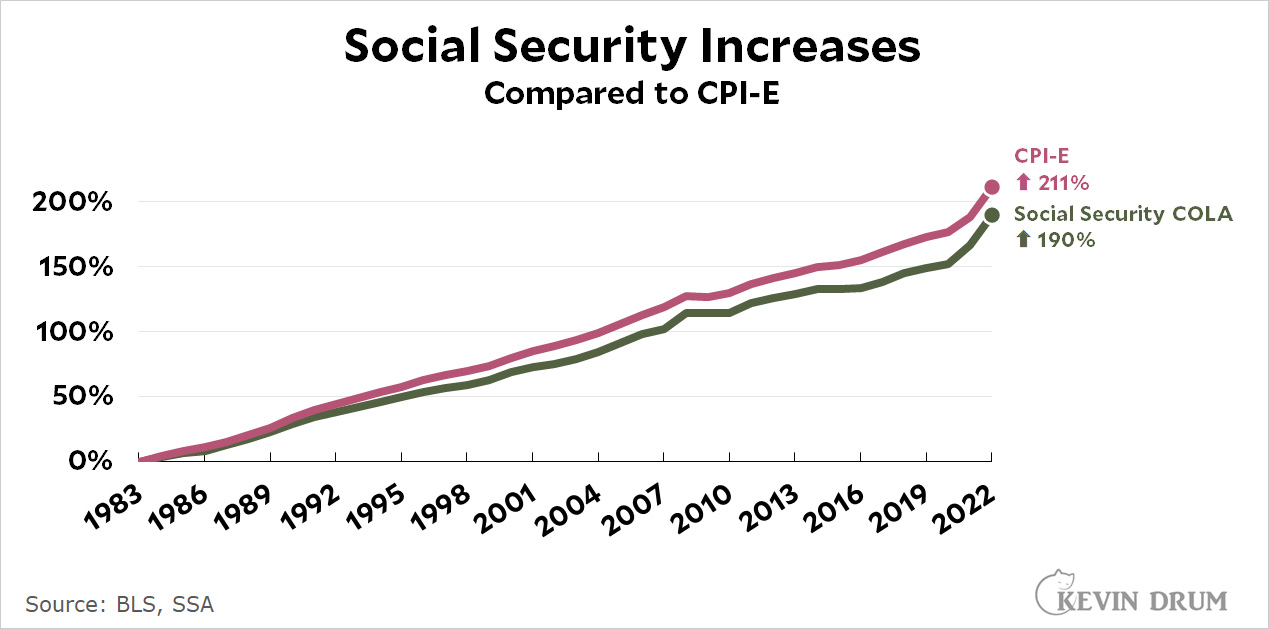 Even with the big increases in recent years, senior citizens are still behind. A $1,000 monthly payment in 1983 should have gone up to $2,111 by now, but instead it's only up to $1,900. That's a shortfall of a couple hundred bucks.
Even with the big increases in recent years, senior citizens are still behind. A $1,000 monthly payment in 1983 should have gone up to $2,111 by now, but instead it's only up to $1,900. That's a shortfall of a couple hundred bucks.
Of course, this assumes you believe in CPI-E in the first place, which not everyone does. Even the BLS points out some potential problems rooted in the fact that CPI research is done on a sample of urban residents that might not match where seniors live. If, on average, they live in cheaper places, then their actual cost of living might be a bit lower than CPI-E suggests.
Medicaid expansion is about to grind to a halt
According to Politico, South Dakota's upcoming approval of Medicaid expansion is likely to be the last one for quite a while. So this is the Medicaid map we're going to have for at least the next few years:
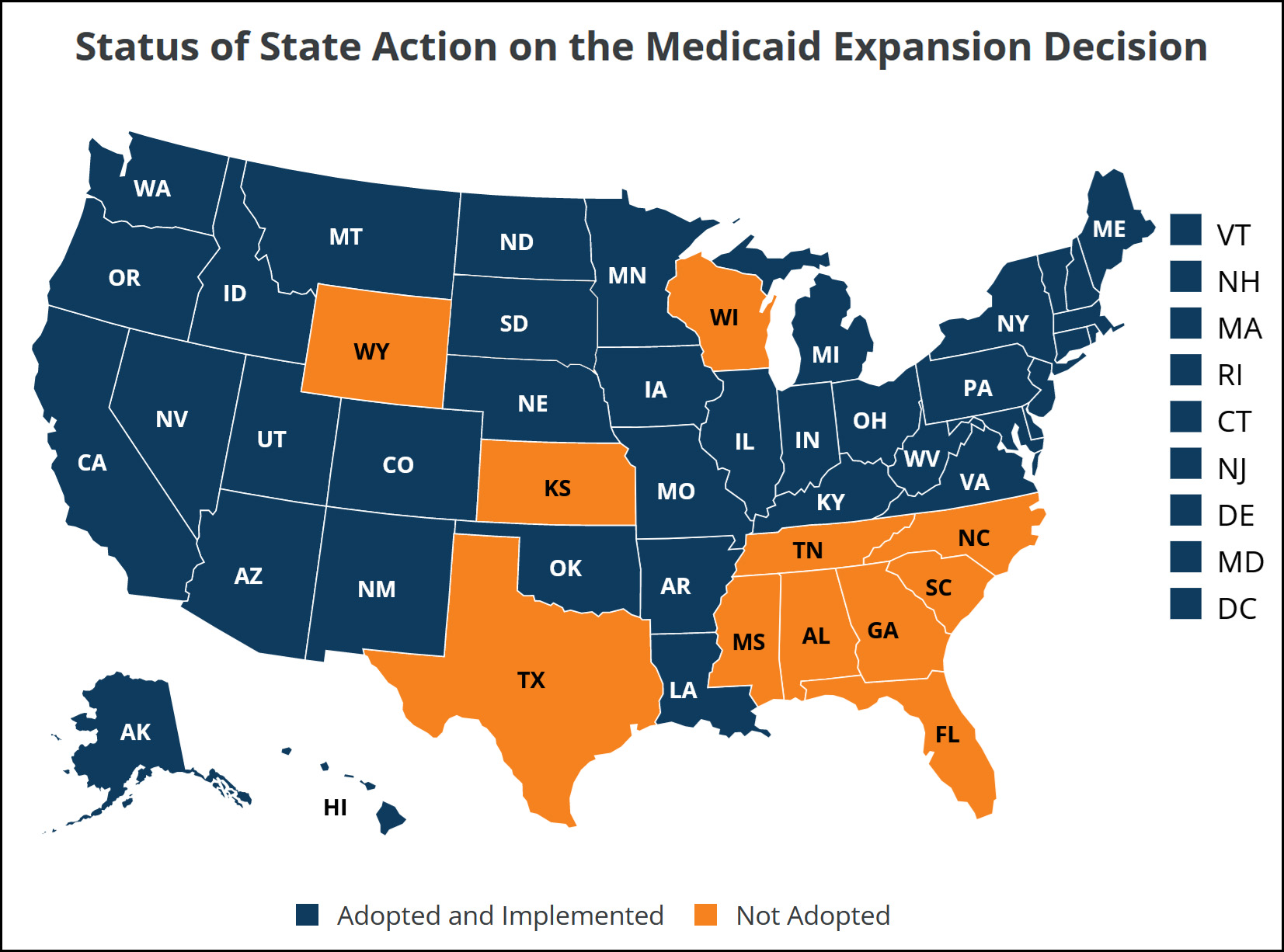 The Black population makes up 14.2% of the entire United States. You will be unsurprised to learn that the average Black population of the Southern holdouts is 24.3%. Only the three Midwestern states have lower than average Black populations.
The Black population makes up 14.2% of the entire United States. You will be unsurprised to learn that the average Black population of the Southern holdouts is 24.3%. Only the three Midwestern states have lower than average Black populations.
The Southern holdouts all have stories to tell about why they refuse to accept Medicaid expansion. It's not part of their culture. They're afraid it might cost too money down the road. They already have plenty of programs for their poor people. Etc. etc.
But what they really mean is that federal money is fine unless it's mostly going to go to low-income Black people. That's been the problem with the American safety net for decades, and it still is today.
Real per-capita retail sales dropped 0.4% in September
Advance retail sales figures for September are out today. And just to be different, I'm reporting them adjusted for both inflation and population growth, annualized into a full-year spending figure.
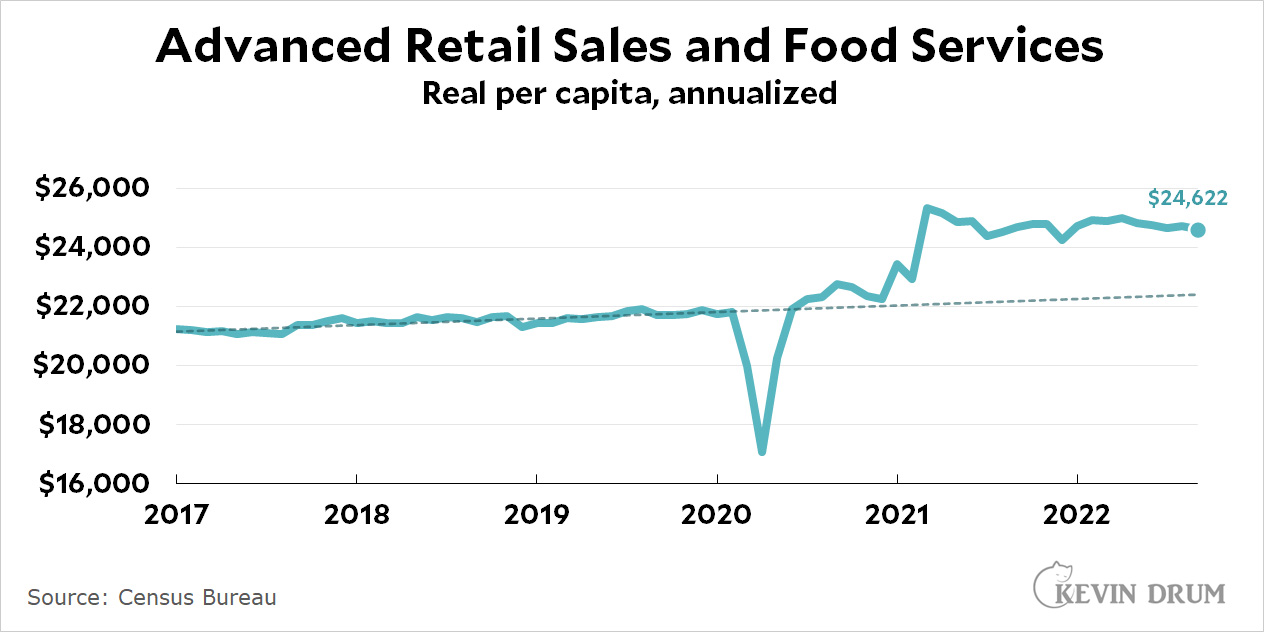 Ordinary newspapers will tell you that retail sales were flat compared to last month, but only this blog will take the next step and adjust for inflation and population growth. When you do that, annualized retail sales were down from $24,725 to $24,622, a decrease of 0.42%. However, we're still spending about 10% more than we would have without the pandemic increase. And this is taking a toll:
Ordinary newspapers will tell you that retail sales were flat compared to last month, but only this blog will take the next step and adjust for inflation and population growth. When you do that, annualized retail sales were down from $24,725 to $24,622, a decrease of 0.42%. However, we're still spending about 10% more than we would have without the pandemic increase. And this is taking a toll:
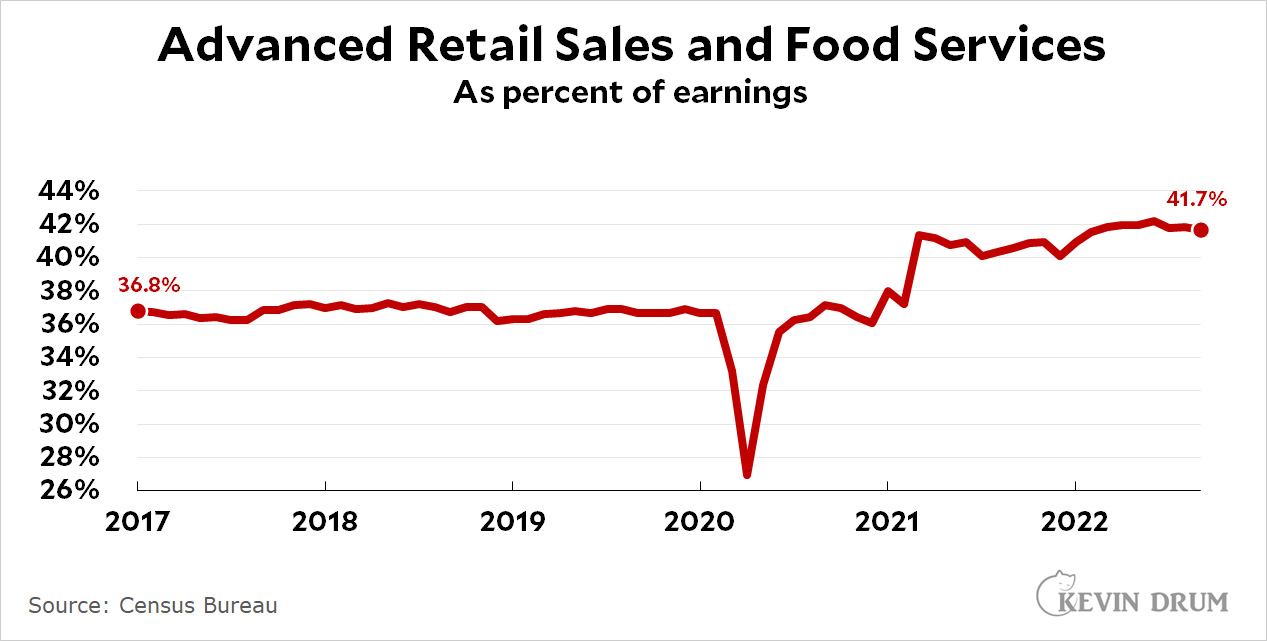 Ideally you'd like to compare household retail sales to household income, but this is the best we can do right now and it's telling in its own right. Five years ago, the average earner spent about 37% of their income on retail purchases. Today it's 42%. That extra 5% has to be coming out of something but I'm not sure what. Certainly not rent or housing, which are also up. Maybe savings? Or debt?
Ideally you'd like to compare household retail sales to household income, but this is the best we can do right now and it's telling in its own right. Five years ago, the average earner spent about 37% of their income on retail purchases. Today it's 42%. That extra 5% has to be coming out of something but I'm not sure what. Certainly not rent or housing, which are also up. Maybe savings? Or debt?
Crime!
I mentioned a few days ago that national crime statistics are hopelessly useless right now, so we don't really know how much crime has gone up or down across the country.
However, we do have crime stats for several big cities, and the one that's getting the most attention right now is New York. So here is major crime in New York City accurate to the week:
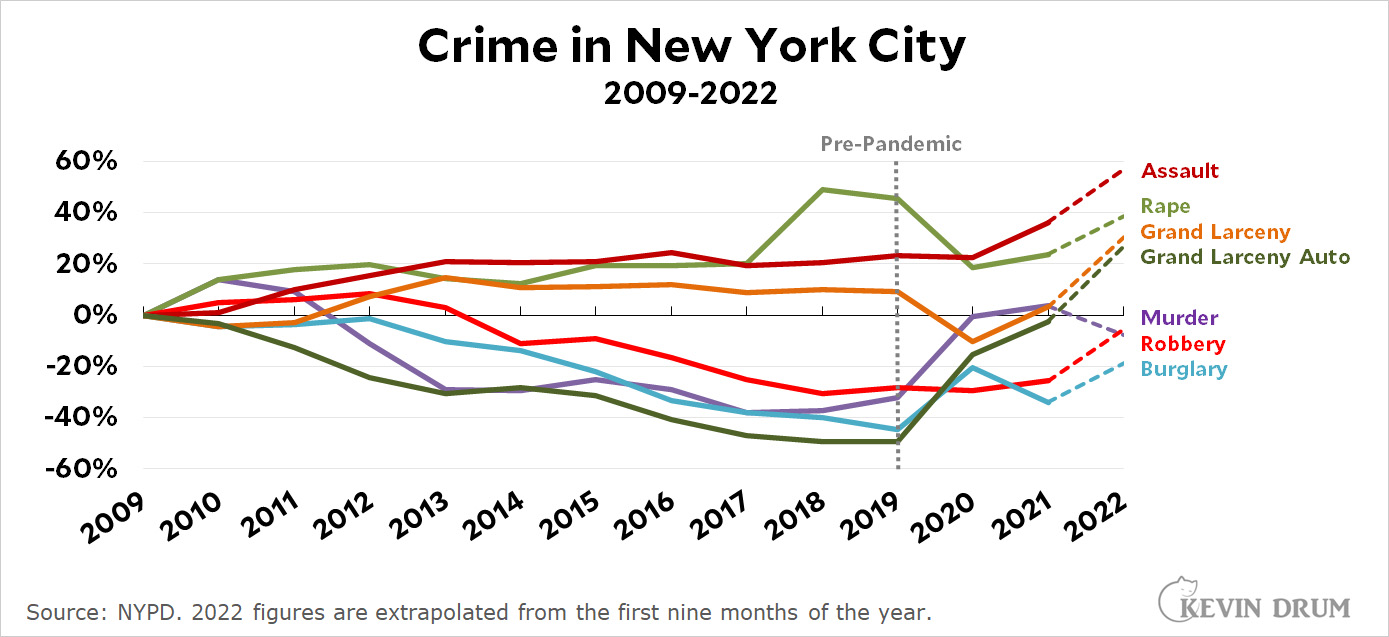 This is hot from the NYPD, so there's no reason to think it's just a guess. This is what they're arresting people for these days.¹
This is hot from the NYPD, so there's no reason to think it's just a guess. This is what they're arresting people for these days.¹
I'm not showing absolute numbers here (they're available from the NYPD if you want to see them). Instead I'm showing growth rates, starting with 2009. As you can see, crime is generally up from last year (dashed lines). Murder is down but everything else is up. It's not good news.
However, you might also want to compare 2022 with 2019, the last pre-pandemic year. The picture is much the same if you do this:
 Murder and auto theft skyrocketed during the pandemic and have stayed high since then—although murder is down a bit this year. The others mostly stayed kind of flat during the pandemic but are up this year.
Murder and auto theft skyrocketed during the pandemic and have stayed high since then—although murder is down a bit this year. The others mostly stayed kind of flat during the pandemic but are up this year.
The big outlier here is murder, which is also what gets the most press attention. Once again, though, I'll point out that this is a huge anomaly. Although murder rates are down a bit this year, they skyrocketed during the pandemic—far more than other violent crimes (rape, assault, robbery). This is unusual since murder rates generally follow other violent crime rates, and that was also true in New York until 2019, when murder started to outpace other serious crimes.² This is very perplexing, but it matches what's happened in the rest of the country too. We keep inventing theories for the increase in murder, but none of them take account of the fact that other serious crimes didn't go up significantly through 2021. Someone needs to figure out what's going on here.
UPDATE: I originally copied the wrong column in the NYPD report for 2022, which made both charts incorrect. They showed crime going generally down, when it was actually going up. I've corrected them and changed the text to reflect it.
¹This is assuming you believe the NYC crime stats, which I admit I'm dubious of.
²Except for auto theft. What's up with that, New York readers?
Lunchtime Photo
Wages were down once again in September
Even with inflation taking less of a bite than earlier in the year, real hourly wages declined yet again in September:
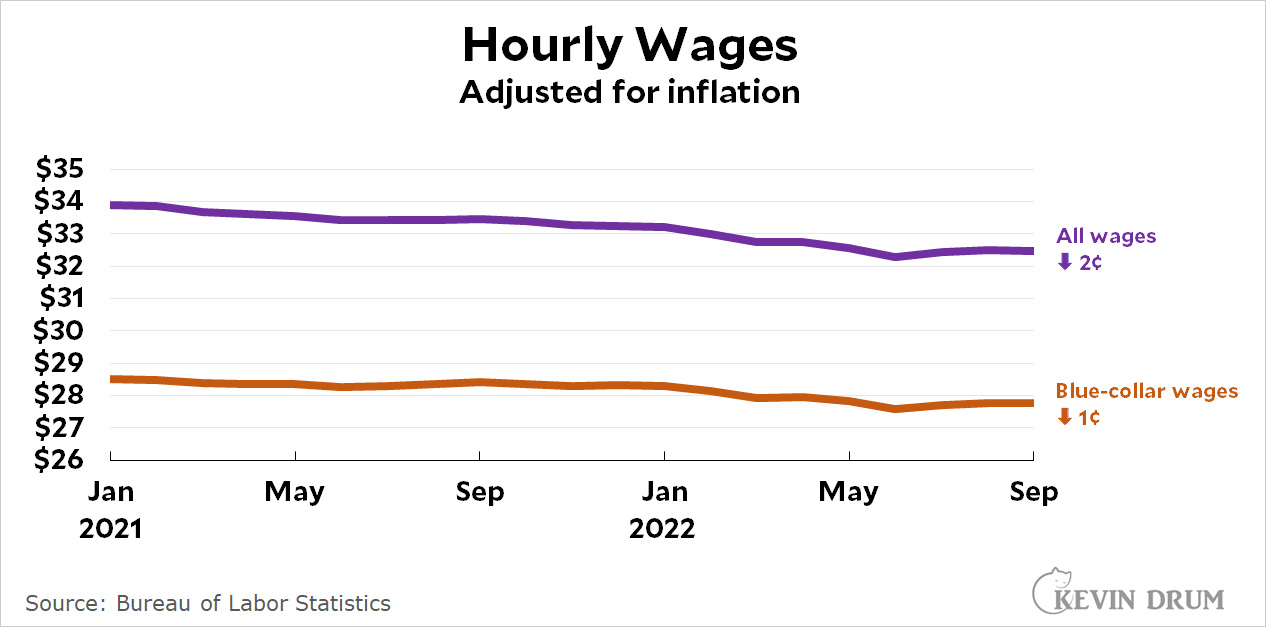 Since the beginning of 2021, hourly earnings are down $1.42. For blue-collar workers, hourly wages are down 73¢. Wages have now fully declined to their pre-pandemic level:
Since the beginning of 2021, hourly earnings are down $1.42. For blue-collar workers, hourly wages are down 73¢. Wages have now fully declined to their pre-pandemic level:
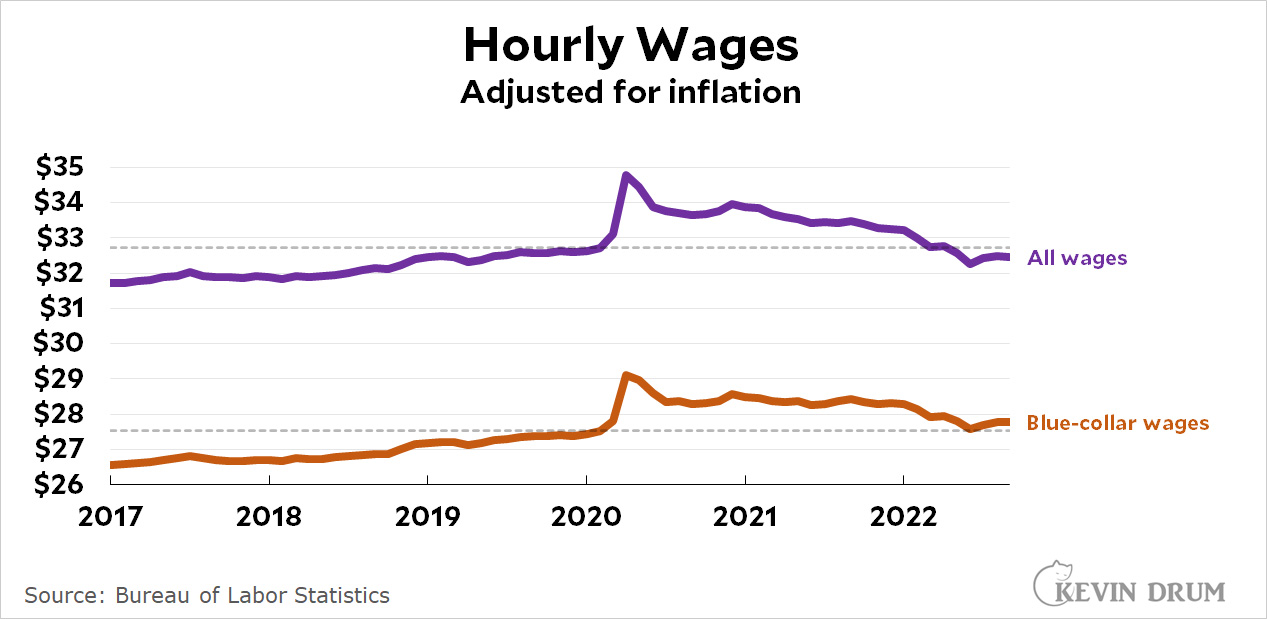 Wages are obviously not pushing up inflation. Nor do wages suggest that employers are really all that concerned about a lack of workers. So what the hell is going on?
Wages are obviously not pushing up inflation. Nor do wages suggest that employers are really all that concerned about a lack of workers. So what the hell is going on?
September inflation remains stubbornly elevated
The BLS announced the CPI for September today, and the month-over-month figure was quite a bit higher than it was last month:
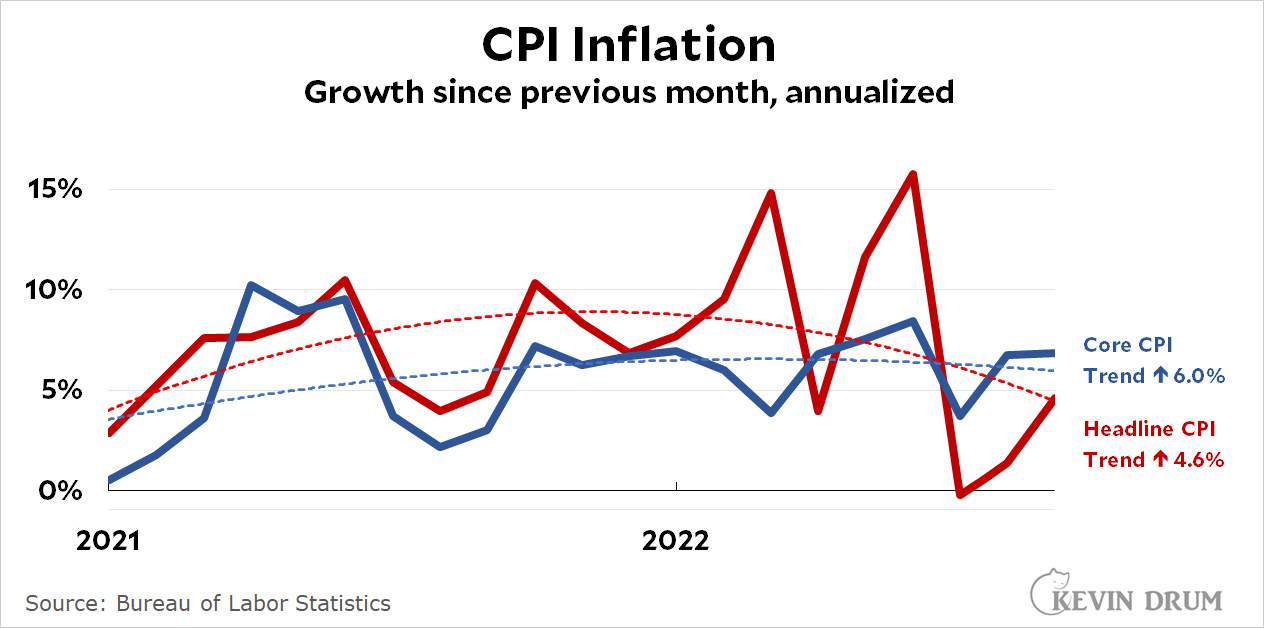 On a year-over-year basis, headline inflation came in at 8.2%, the same as last month. Core CPI rang in at 6.6%.
On a year-over-year basis, headline inflation came in at 8.2%, the same as last month. Core CPI rang in at 6.6%.
As always, though, the trendline is the thing to watch. The trend for headline inflation declined to 4.6% while the trend for core CPI was pretty much unchanged at 6.0%. That's only slightly lower than its peak trend rate of 6.5% in April.
Gasoline was down again in September, but food prices remained up about 10% on an annualized basis.
There's not much good news in this report. Core CPI in particular is only barely declining. I will be interested to see if PCE inflation shows the same thing. We'll find out in two weeks.
Raw data: Men and women after the pandemic
Enough time has now passed that we can take a good look at how men and women responded to getting back to work after the pandemic:
 In 2016 women began entering the workforce at a higher rate than men. At the start of the pandemic, however, they lost more than men: a 4.6 point drop in labor participation compared to a 3.2 point drop for men.
In 2016 women began entering the workforce at a higher rate than men. At the start of the pandemic, however, they lost more than men: a 4.6 point drop in labor participation compared to a 3.2 point drop for men.
After the pandemic they more than made this up. As of now, women have returned to their pre-pandemic participation rate (77% of women are currently in the labor force) while men are still at their 2013 rate (88%).
In 1960, women participated in the labor force at 43% of the rate of men (42% vs. 97%). Today it's an 87% ratio (77% vs. 88%). This is due to a steady decline in work among men and a steady increase among women.¹
¹Until 2000, anyway, when women's participation flattened out.
Donald Trump is careening down a rabbit hole of legal pain
Donald Trump's problems with the law have certainly heated up in the past couple of days. Here's what we've learned:
- On January 6, Donald Trump was desperate to march on the Capitol with the mob, but the Secret Service directly disobeyed him and refused.
- Surveillance video shows a Trump aide moving boxes out of a Mar-a-Lago storage room prior to the FBI search in August and then moving them back in after the FBI left.
- The Justice Department has told Trump that they don't believe he's returned all the documents he took from the White House.
- A federal judge has ordered Trump to provide a deposition under oath in the case of E. Jean Carroll, who claims that Trump raped her in a dressing room in the 1990s.
And all this is in addition to Trump's problems with both the New York attorney general (tax fraud) and the Georgia attorney general (election fraud). Things are not looking good for the former president.


